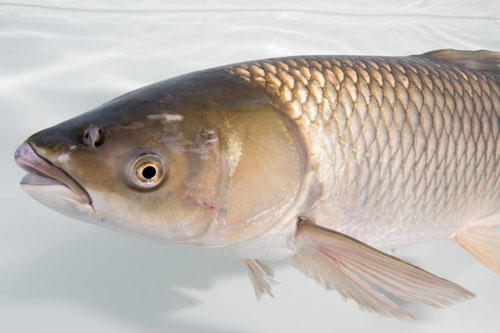The grass carp, also known as white amur, is a non-native fish that is established in parts of North America.
Grass carp have slender bodies that are usually bronze above and silver to white below. Grass carp can weight up to 80 pounds or more and reach lengths greater than 48 inches.
The species is one of the four major Asian aquaculture carps, which also includes silver carp, bighead carp, and black carp. In the USA, the four species are known collectively as “invasive carp.”
Grass carp prefer large lakes, rivers, and other water bodies with abundant vegetation and slow-moving water. They tolerate smaller ponds and reservoirs if food sources are available.
The species is considered to be extremely effective as a biological control of aquatic plants. A single grass carp can eat 100% of its body weight in vegetation each day.
Even heavy infestations can be brought under control by this plant eater, although greater quantities of grass carp may be required per acre.
Unlike other invasive carp, grass carp can be caught with baited lines. They respond well to attractants such as corn. Anglers use a variety of fruit, vegetable, and grain-based baits.
Popular baits include canned corn, lima beans, kidney beans, watermelon, pineapple, mullberries, and cherries. Anglers also catch grass carp with doughballs and earthworms.
An effective technique for catching grass carp is sight casting. Anglers start by scouting an area until carp are located. Grass carp at the surface are usually identified by their dorsal fin or mouth.
Once located, anglers may deploy chum or simply cast baits directly to cruising fish. Although baits are preferred by many, some anglers cast artificial lures or employ fly fishing gear. Grass carp can also taken by alternative fishing methods, especially bowfishing.
Grass carp are sometimes confused with the common carp, another introduced species.
